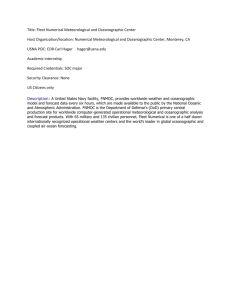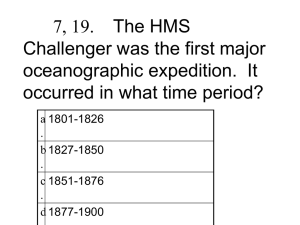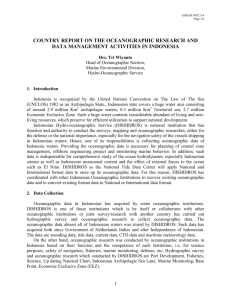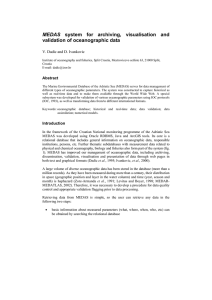Contributions of animal-borne sensors to understanding broad
advertisement
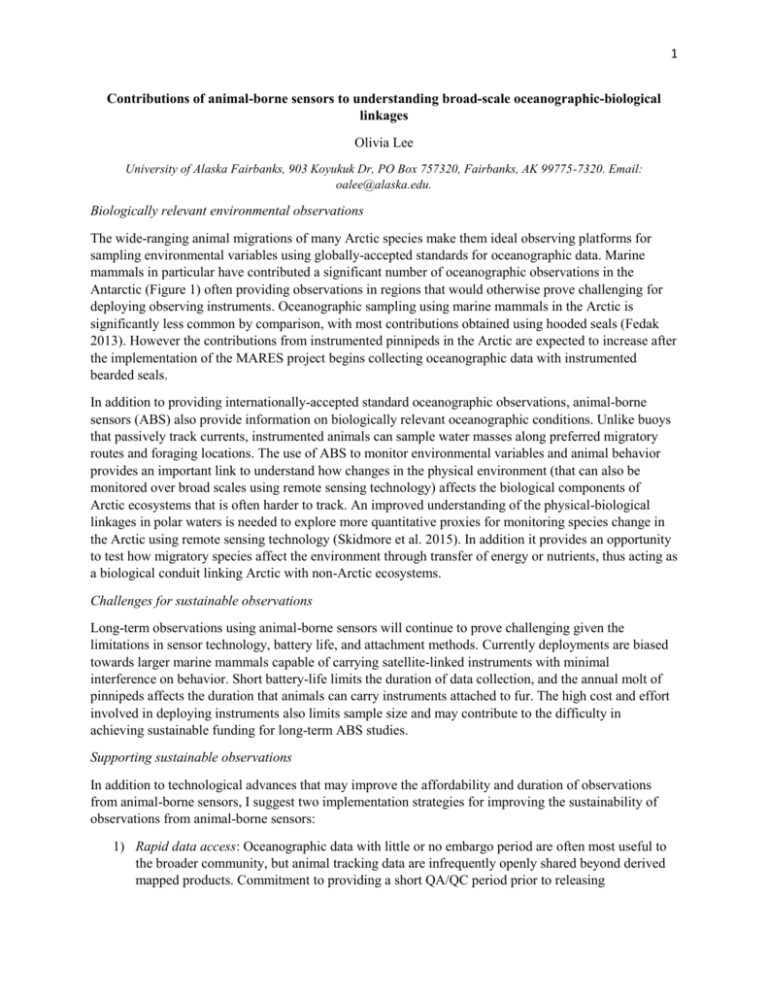
1 Contributions of animal-borne sensors to understanding broad-scale oceanographic-biological linkages Olivia Lee University of Alaska Fairbanks, 903 Koyukuk Dr, PO Box 757320, Fairbanks, AK 99775-7320. Email: oalee@alaska.edu. Biologically relevant environmental observations The wide-ranging animal migrations of many Arctic species make them ideal observing platforms for sampling environmental variables using globally-accepted standards for oceanographic data. Marine mammals in particular have contributed a significant number of oceanographic observations in the Antarctic (Figure 1) often providing observations in regions that would otherwise prove challenging for deploying observing instruments. Oceanographic sampling using marine mammals in the Arctic is significantly less common by comparison, with most contributions obtained using hooded seals (Fedak 2013). However the contributions from instrumented pinnipeds in the Arctic are expected to increase after the implementation of the MARES project begins collecting oceanographic data with instrumented bearded seals. In addition to providing internationally-accepted standard oceanographic observations, animal-borne sensors (ABS) also provide information on biologically relevant oceanographic conditions. Unlike buoys that passively track currents, instrumented animals can sample water masses along preferred migratory routes and foraging locations. The use of ABS to monitor environmental variables and animal behavior provides an important link to understand how changes in the physical environment (that can also be monitored over broad scales using remote sensing technology) affects the biological components of Arctic ecosystems that is often harder to track. An improved understanding of the physical-biological linkages in polar waters is needed to explore more quantitative proxies for monitoring species change in the Arctic using remote sensing technology (Skidmore et al. 2015). In addition it provides an opportunity to test how migratory species affect the environment through transfer of energy or nutrients, thus acting as a biological conduit linking Arctic with non-Arctic ecosystems. Challenges for sustainable observations Long-term observations using animal-borne sensors will continue to prove challenging given the limitations in sensor technology, battery life, and attachment methods. Currently deployments are biased towards larger marine mammals capable of carrying satellite-linked instruments with minimal interference on behavior. Short battery-life limits the duration of data collection, and the annual molt of pinnipeds affects the duration that animals can carry instruments attached to fur. The high cost and effort involved in deploying instruments also limits sample size and may contribute to the difficulty in achieving sustainable funding for long-term ABS studies. Supporting sustainable observations In addition to technological advances that may improve the affordability and duration of observations from animal-borne sensors, I suggest two implementation strategies for improving the sustainability of observations from animal-borne sensors: 1) Rapid data access: Oceanographic data with little or no embargo period are often most useful to the broader community, but animal tracking data are infrequently openly shared beyond derived mapped products. Commitment to providing a short QA/QC period prior to releasing 2 oceanographic data through commonly-used ocean data access sites (e.g. sites where similar GEOSS observing data can be accessed) would increase the use and demand for ABS data. 2) Coordination with the modeling community: Contributions from ABS towards validation of modeled oceanographic output may provide significant benefits. ABS data may help modelers gain additional insight into how species and ecosystems respond to environmental changes in the ocean. Such efforts would require conscientious coordination between modelers and biologists in order to develop, test, and validate hypotheses of physical-biological linkages in the Arctic. Establishment of strong partnerships between the ocean-observing, and marine mammal research communities as well as a commitment to open data access are essential for promoting sustainable observations using ABS. However, the full value of using ABS on migratory species to improve understanding of oceanographic-biological linkages over broad scales has not yet been fully investigated in the Arctic. Figure 1. Distribution of CTD casts from animal-borne sensors. Source: National Oceanographic Data Center. References Fedak, M. A. (2013). The impact of animal platforms on polar ocean observation. Deep Sea Research Part II: Topical Studies in Oceanography, 88, 7-13. 3 Skidmore, A.K., Pettorelli, N., Coops, N. C., Geller, G. N., Hansen, M., Lucas, R., Mücher, C.A., O'Connor, B., Paganini, M., Pereira, H. M., Schaepman, M. E., Turner, W., Wang T., & Wegmann, M. (2015) Nature, 523, 403-405. doi:10.1038/523403a
